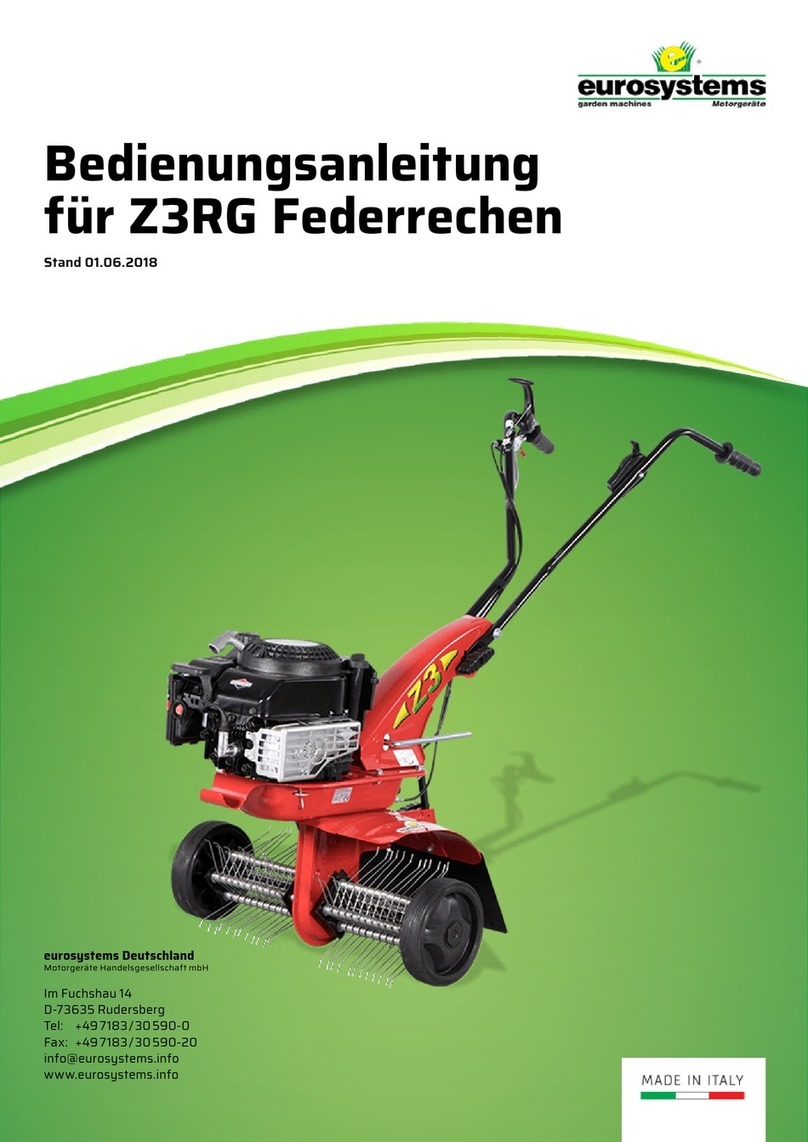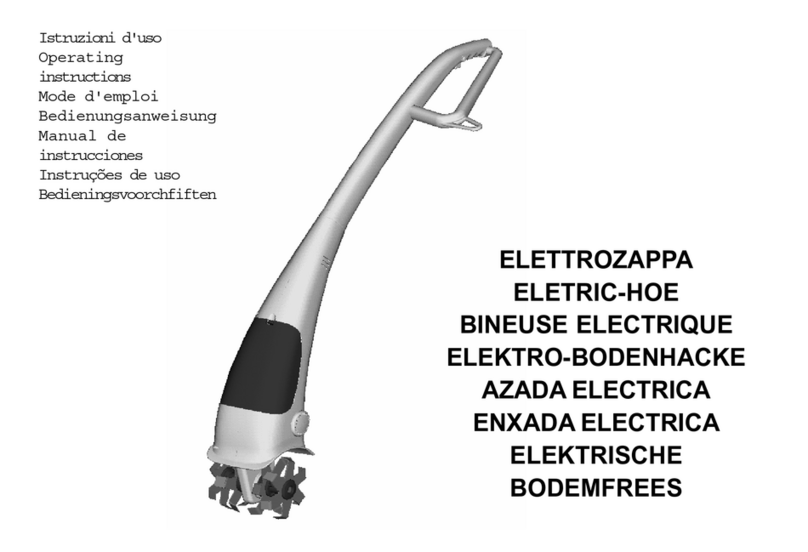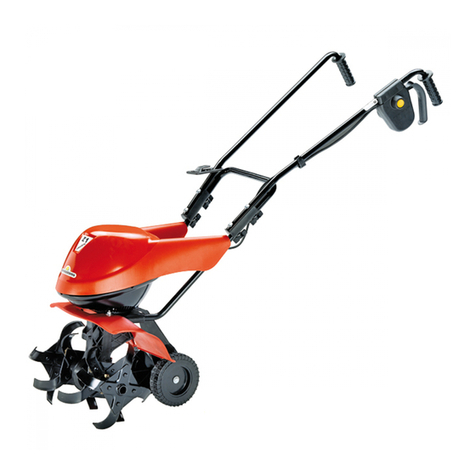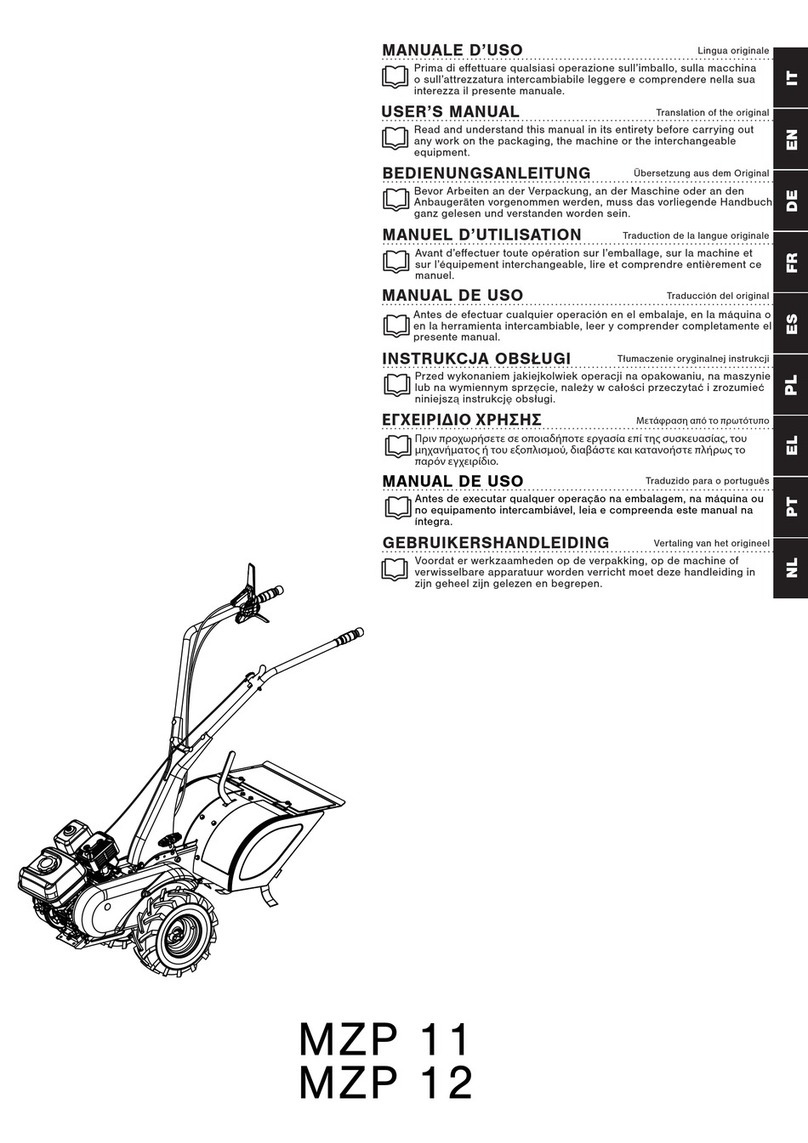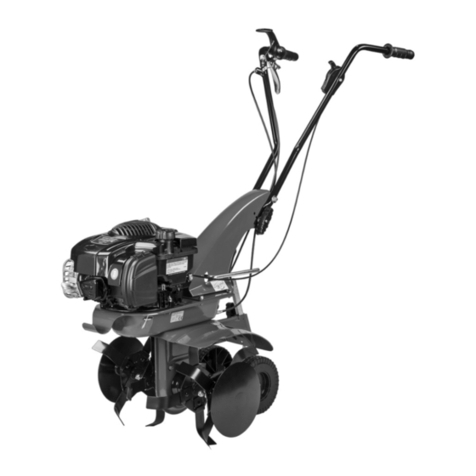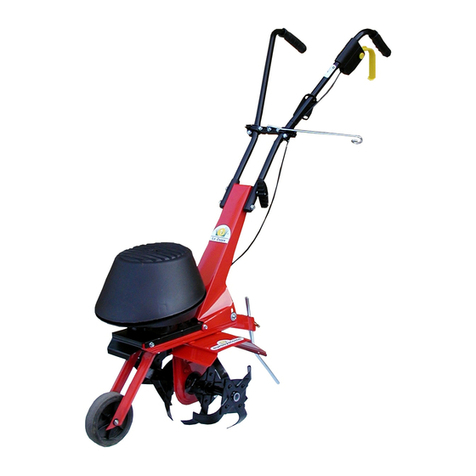
energico.
- Marcia avanti (Fig. 6) : A motore avviato appoggiare i coltelli sul terreno e, tenendo saldamente la motozappa, inlare nel terreno lo sperone. Impugnare
le stegole e premere il fermo di sicurezza (13) che impedisce l’innesto accidentale delle frese. Tirare la leva avanzamento (2) per tutta la sua corsa.
- Marcia indietro: rilasciare la leva avanzamento (g.6, part.2) e tirare verso di sé l’altra leva posta sulla stegola.(1)
Questa motozappa è progettata per ridurre al minimo le emissioni di vibrazioni e rumore, tuttavia è buona norma intervallare lavori di lunga durata
con piccole pause.
- Fine lavoro: terminato il lavoro, per arrestare il motore, portare la levetta dell’acceleratore (g. 5 part.2) nella posizione STOP.
n SOSTITUZIONE OLIO NELLA TRASMISSIONE INFERIORE (Fig. 9) In linea di massima si dovrebbe sostituire l’olio ogni 100
ore di lavoro (viscosità olio SAE 80 ).Procedere come segue: A) allentare il tappo a vite(1). B) collocare la macchina in posizione inclinata e aspirare
l’olio tramite una siringa. C) introdurre olio nuovo nella quantità di circa 0,2 litri per modello motozappa larghezza cm.40; quantità di crca 0,5 litri per
modello motozappa larghezza cm. 50. Per vericare il livello olio: Mettere la macchina in posizione orizzontale; svitare il tappo e controllare che
l’olio sia al livello inferiore del foro. Il tappo di riempimento e svuotamento corrisponde al livello olio.
IMPORTANTE! Per evitare l’inquinamento delle falde acquifere, l’olio esausto non deve essere gettato in scarichi fognari o canali idrici. Depositi
per l’olio esausto sono ubicati presso tutti i distributori di benzina, oppure in discariche autorizzate secondo le normative comunali del Comune di
residenza.
n MANUTENZIONE FRESE A ZAPPETTE Pulire i mozzi delle frese, l’albero porta frese e la parte tagliente delle zappette dai residui di
terra, erba, li di ferro, corde ecc.
n MANUTENZIONE MOTORE (vedere la pubblicazione specica) La motozappa viene consegnata con il motore a 4 tempi senza
olio. Riempire il serbatoio no al livello indicato (capacità circa 0,5 Kg). Usare olio tipo Multigrade con viscosità 10-40 w.
n RIMESSAGGIO Mantenere serrati tutti i dadi, i bulloni e le viti per garantire il funzionamento della macchina nelle condizioni di sicurezza. Lasciar
raffreddare la macchina prima di immagazzinarla e comunque non riporla con benzina nel serbatoio all’interno di un edicio, dove i vapori possono
raggiungere una amma libera o una scintilla. Svuotare il serbatoio all’esterno. Per ridurre il pericolo di incendio mantenere il motore, il silenziatore e
la zona di immagazzinamento della benzina liberi da foglie, erba e grasso in eccesso.
n DESCRIZIONE COMPONENTI MACCHINA (Fig. 8) 1) Leva comando acceleratore. 2) Leva comando marcia di zappatura. 3) Leva
comando RM. 4) Maniglia per avviamento a strappo del motore. 5) Sperone per regolazione fresatura. 6) Frese. 7) Riparo frese. 8) Dischi proteggipiante
(solo per mod. Z3).
n DATI TECNICI MOTOZAPPA Z2: Motore: per informazioni vedere la pubblicazione specica. Larghezza di lavoro delle frese è di 40
cm.,complete di carter di protezione. La velocità massima di rotazione della fresa è di 120 giri/minuto circa. Cambio: marcia avanti o marcia avanti
+ retromarcia. Peso della motozappa completa è di Kg. 32. Dimensioni della motozappa: lunghezza massima 1,30 mt. larghezza massima 0,40 mt.
altezza 1,10 mt.
n DATI TECNICI MOTOZAPPA MOD. Z3 Motore: per informazioni vedere la pubblicazione specica. Larghezza di lavoro delle frese è
di 50 cm.,complete di carter di protezione. La velocità max.di rotazione della fresa è di 130 giri/minuto circa. Cambio: marcia avanti o marcia avanti
+ retromarcia. Peso della motozappa completa è di Kg.44. Dimensioni della motozappa: lunghezza massima 1,30 mt. Larghezza massima 0,50 mt.
Altezza 1,10 mt.
4
I
